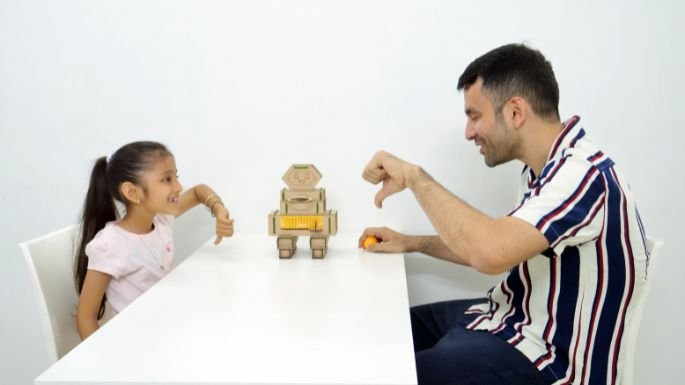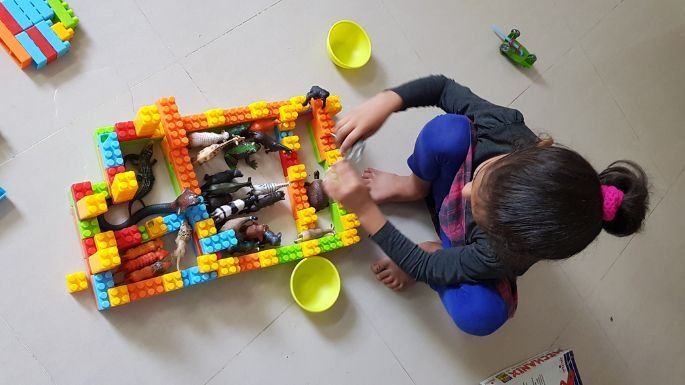

Imagine walking into a grade 9 classroom where students are building tiny robots. One group debates how to make their robot turn corners faster, another is testing a new arm attachment to grab objects, and a third group bursts into cheers as their creation finally crosses the finish line. This isn’t a science fiction scene—it’s the Creative Play!
That same evening Mitthu’s mother had a boardroom meeting where a visiting consultant made all the board members play a board game. He wanted to convey the effectiveness of recruiting interns and freshers even into complex job practices through this board game. Again this is the power of Creative Play.
And the next day 5 year old Chaitanya was playing the role of “Chaitanya Mahaprabhu” at a drama in the school. Chaitanya, the shy little boy who would never sing a song in presence of their extended family, had sung and danced in the presence of 400+ strangers present in the auditorium. That’s the power of Creative Play.
Lastly, Did you know that Misari is very well known as the Creative Playmaker in her football team?
After all, what is this creative play? Let’s delve deeper to know creative play, its advantages, importance, its impact on our mood, physical, emotional and mental health. Will also understand how relevant creative play is for various age groups. And all of these will come with robust backing for scientific research.
Examples of creative play
Key Characteristics of Creative Play
Benefits of Creative Play for Kids
The value of creative play for adults
Real life benefits of creative play for adults
Creative play in education
Can sports, dance, music be considered creative play?
Sports as creative play
Dance as Creative Play
Music as Creative Play
Research Supporting Sports, Dance, and Music as Creative Play
Real-Life Examples of Sports, Dance, and Music as Creative Play
What is Creative Play?
Creative play is play or an activity that allows individuals to use their imagination, curiosity, and creativity to explore and express themselves. Here the focus is on the process rather than the outcome.
Though creative play is for everyone, all genders and all age groups, it’s more commonly referred for children.
Examples of creative play
- Building and Constructing: Using blocks, LEGO, or DIY robotics kits to create structures or functional objects.
- Role-Playing: Pretending to be a doctor, chef, superhero, or teacher.
- Art and Craft: Drawing, painting, sculpting, or crafting with recycled materials.
- Storytelling: Creating and narrating original stories or acting out scenes with toys or puppets.
- Board games, puzzles and card games: Fosters interpersonal communication, building strategies and solving problems.
- Music and Dance: Experimenting with instruments, making rhythms, or creating dance routines.
- Outdoor Exploration: Using natural elements like leaves, stones, or mud for play or art.
- Sports: Trying new ways to bowl in the game of cricket, riding new trails, hiking solo or with an unknown set of people, preparing new ground formation for football match.
Key characteristics of creative play
- Imagination-Driven: Encourages the use of imagination to create scenarios, stories, or solutions.
- Open-Ended: In many cases, there are no predefined rules, or limitations, allowing for flexibility and personal expression.
- Process-Oriented: Focuses on the enjoyment and exploration of the activity rather than achieving a specific result.
- Child-Led: Involves minimal adult interference, empowering children to take charge of their play.
- Diverse Tools and Mediums: Uses a variety of materials, from toys and art supplies to natural objects and digital tools.

Benefits of creative play for kids
- Enhances Problem-Solving Skills: Encourages finding innovative solutions and thinking critically.
- Boosts Emotional Development: Provides a safe outlet for expressing feelings and emotions.
- Improves Social Skills: Encourages collaboration, negotiation, and communication during group play.
- Builds Confidence: Helps children trust their instincts and take pride in their creations.
- Develops Fine and Gross Motor Skills: Through activities like drawing, cutting, or constructing.
- Encourages Lifelong Curiosity: Instills a love for exploration and learning.
The value of creative play for adults
Creative play is often associated with children, but research shows it has profound benefits for adults as well. Engaging in creative play helps adults relax, unlock their potential, and develop innovative thinking. It reconnects us with our innate curiosity and ability to problem-solve in a low-pressure, enjoyable environment.
Real life benefits of creative play for adults
1. Stress Reduction and Mental Health Improvement
- Benefit: Activities like doodling, role-playing, or crafting help release dopamine, a neurotransmitter associated with pleasure and relaxation, reducing stress and improving mood.
- Scientific Backing: A 2016 study published in the Journal of the American Art Therapy Association found that just 45 minutes of creative activity significantly reduced cortisol levels (a stress hormone) in adults.
- Example: Adult coloring books help people focus, relax, and meditate.
2. Enhanced Problem-Solving and Innovation
- Benefit: Play encourages divergent thinking, helping adults approach problems with creativity and flexibility.
- Scientific Backing: Research from the Journal of Experimental Social Psychology (2011) demonstrated that engaging in playful activities like brainstorming with toys or role-playing fosters creative problem-solving.
- Example: Design thinking workshops often incorporate playful elements like LEGO Serious Play and Havi Elements to help participants ideate and innovate.
3. Improved Social Connections
- Benefit: Group-based creative play fosters collaboration, empathy, and better communication.
- Scientific Backing: Studies in Frontiers in Psychology (2019) highlight that cooperative play boosts social bonds and trust among participants.
- Example: Team-building exercises using games or theatre improve workplace dynamics.
4. Cognitive Enhancement and Learning
- Benefit: Activities like puzzles, role-playing, or learning new artistic skills stimulate brain function and improve memory and focus.
- Scientific Backing: Research from the National Institute on Aging found that mentally stimulating activities delay cognitive decline and protect against conditions like dementia.
- Example: Adults who engage in DIY robotics kits or building projects sharpen their technical skills and learn hands-on problem-solving.

5. Boosted Productivity and Job Satisfaction
- Benefit: Taking breaks for creative play recharges the mind and leads to higher productivity levels.
- Scientific Backing: A study in Harvard Business Review (2018) reported that employees who engage in playful activities during breaks are more focused and satisfied with their work.
- Example: Companies like Google and IDEO encourage play zones and activities in offices to inspire creativity and foster innovation.
6. Emotional Expression and Healing
- Benefit: Creative play offers a non-verbal outlet to process and express emotions.
- Scientific Backing: Art therapy research in the American Journal of Occupational Therapy shows that creative activities reduce anxiety and help people cope with trauma.
- Example: Adults participating in creative writing workshops often report a better understanding of their emotions and increased resilience.
7. Rediscovering Joy and Curiosity
- Benefit: Playful activities help adults reconnect with a sense of wonder and joy often lost in the rigours of daily life.
- Scientific Backing: Neuroscientist Dr. Stuart Brown, in his book Play: How it Shapes the Brain, emphasizes that play is crucial for well-being and fosters curiosity and resilience.
- Example: Engaging in hobbies like pottery or dance brings adults a sense of fulfillment and childlike joy.
How Creative Play is Useful in Education
Creative play is incredibly useful in education, and its benefits extend beyond children to people of all ages, including youngsters, adults, and even seniors. It is a versatile and effective tool for learning, as it fosters engagement, critical thinking, and skill development in ways that traditional methods often cannot achieve.
1. Enhances Engagement and Motivation
- Play makes learning fun and interactive, reducing resistance to studying and increasing motivation.
- Example: Role-playing historical events helps students actively immerse themselves in history lessons.
2. Encourages Critical Thinking and Problem-Solving
- Creative play challenges learners to think outside the box, solve problems, and make decisions.
- Example: Building a functional bridge using popsicle sticks encourages engineering thinking and teamwork.
3. Facilitates Deeper Understanding
- Hands-on and experiential activities solidify abstract concepts.
- Example: Using LEGO bricks to teach fractions helps students visualize and manipulate mathematical ideas.
4. Boosts Creativity and Innovation
- Play allows learners to experiment without fear of failure, sparking creativity.
- Example: Writing and performing a play based on a novel encourages imaginative interpretation.
5. Develops Social and Emotional Skills
- Group play fosters collaboration, empathy, and conflict resolution.
- Example: Team-based problem-solving activities in classrooms build interpersonal skills.
6. Supports Lifelong Learning
- Encourages curiosity and adaptability, essential for a rapidly changing world.
- Example: Adults in professional workshops using gamified simulations to learn leadership skills.
Research Supporting Creative Play in Education
- For Children: A study in Child Development (2010) found that children who engage in imaginative play have higher levels of cognitive flexibility and problem-solving skills.
- For Teens: Research in Psychology in the Schools (2018) highlighted the role of gamified learning in improving academic performance and student engagement.
- For Adults: A 2021 study in the Journal of Workplace Learning showed that gamified professional training led to a 25% increase in retention and application of new skills.
- For Seniors: Studies in Frontiers in Aging Neuroscience (2020) indicate that playful activities like puzzles and creative storytelling can delay the onset of dementia and enhance quality of life.
It emphasizes open-ended, self-directed activities where the focus is on the process rather than the outcome. Creative play fosters problem-solving, emotional expression, and the development of various skills, such as social, cognitive, and physical abilities.
Can sports, dance, music be considered creative play?
Yes, sports, dance, and music can absolutely be considered forms of creative play, as they share many of the key characteristics that define creative play, such as self-expression, imagination, skill development, and enjoyment of the process.
Sports as creative play
- Imagination and Strategy: Many sports involve strategic thinking, quick decision-making, and adaptability, which engage the creative mind. For example, in basketball, players often need to invent plays on the spot.
- Social Interaction: Team sports enhance collaboration, empathy, and communication, all of which align with the social aspects of play.
- Creative Exploration: Sports like parkour, skateboarding, and freestyle football are inherently creative, as participants invent new moves and push the boundaries of physical expression.
- Stress Relief: Sports provide a playful outlet to release tension and promote mental well-being.
Dance as creative play
- Self-Expression: Dance is a direct form of creative expression where individuals communicate emotions, stories, and ideas through movement.
- Improvisation: Freestyle dancing or improvisational dance encourages unstructured, imaginative exploration.
- Connection with Others: Group dance or partner dances like salsa or swing foster social bonds and collaborative creativity.
- Therapeutic Benefits: Dance has been used as a form of therapy (Dance Movement Therapy) to help individuals express and process emotions.
Music as creative play
- Imaginative Composition: Playing instruments, composing songs, or even karaoke involves imagination and personal interpretation.
- Emotional Exploration: Music allows individuals to explore and express a wide range of emotions creatively.
- Improvisation: Jazz, in particular, is a highly improvisational form of music, encouraging spontaneity and innovation.
- Brain Engagement: Playing music stimulates multiple areas of the brain, improving cognitive abilities and creativity.
Research Supporting Sports, Dance, and Music as Creative Play
- Sports and Creativity: A study published in Psychology of Sport and Exercise (2014) found that engaging in sports requiring quick decision-making enhances creative thinking and problem-solving skills.
- Dance and Mental Health: Research in the Journal of Dance Movement Therapy highlights that dance increases endorphin levels, reduces stress, and boosts self-esteem, all hallmarks of creative play’s emotional benefits.
- Music and Cognitive Growth: According to a study in Nature Neuroscience (2007), playing music strengthens neural pathways associated with creativity, memory, and emotional processing.
Real-Life Examples of Sports, Dance, and Music as Creative Play
- Sports: A footballer invents a unique trick during a match, showcasing creativity in action.
- Dance: Flash mobs or street dances where individuals spontaneously create choreography.
- Music: A jam session where musicians improvise and create something new together.
Creative play is a powerful educational and entertainment tool for all age groups, from children learning basic skills to adults and seniors exploring personal growth and lifelong learning. Its flexibility, accessibility, and proven benefits make it an essential part of education and personal development at every stage of life.
And that’s why at havi, we strive to engage you into Creative Play. Keep playing, keep creating, keep performing.
Also Read
